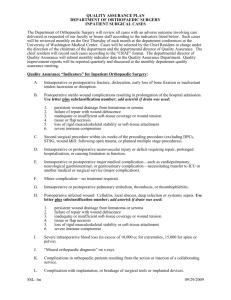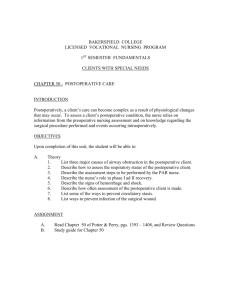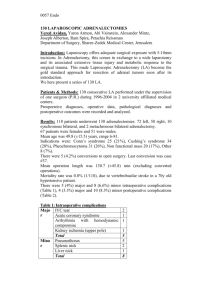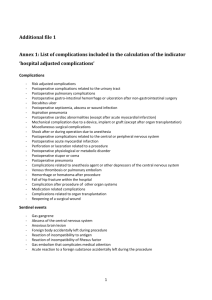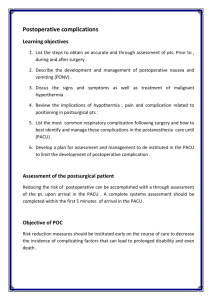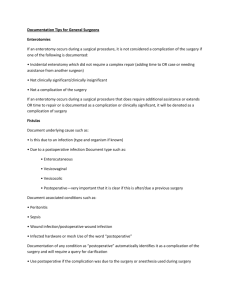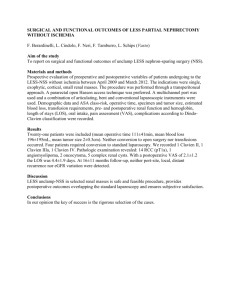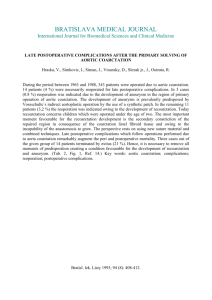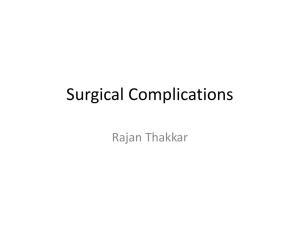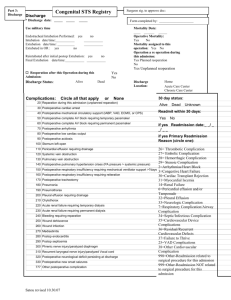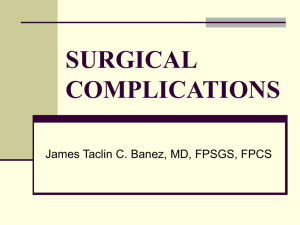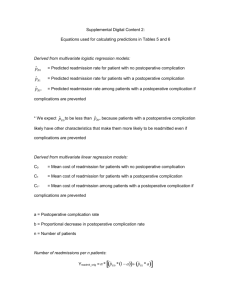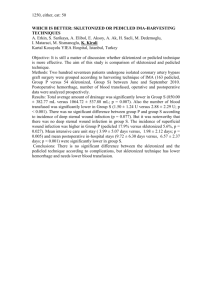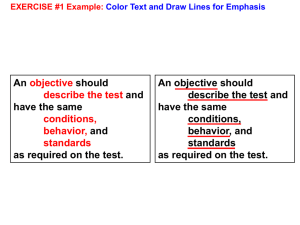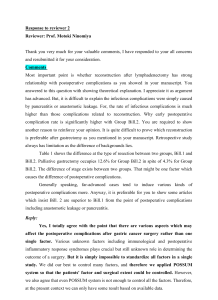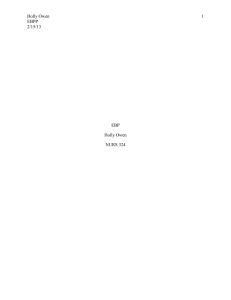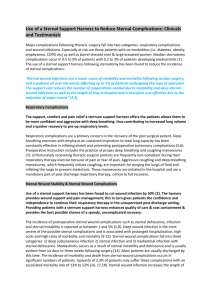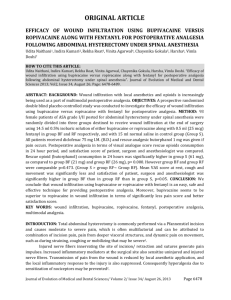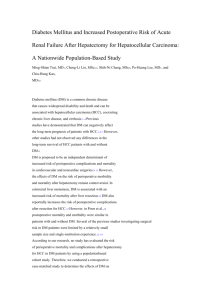Post operative care and postoperative complications
advertisement
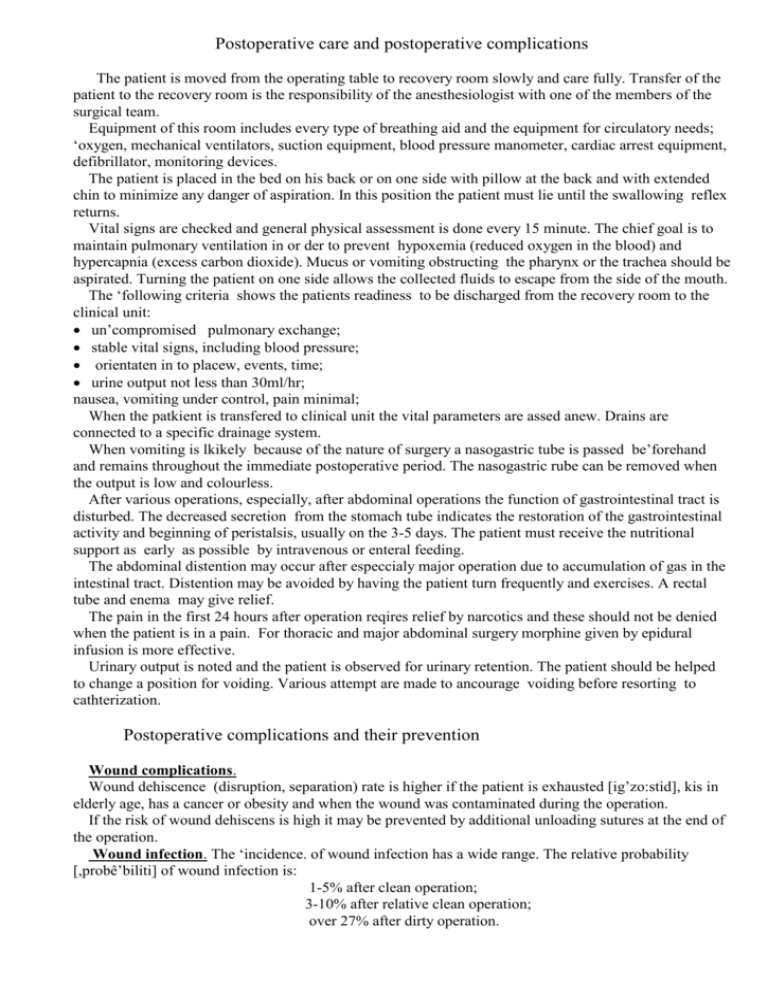
Postoperative care and postoperative complications The patient is moved from the operating table to recovery room slowly and care fully. Transfer of the patient to the recovery room is the responsibility of the anesthesiologist with one of the members of the surgical team. Equipment of this room includes every type of breathing aid and the equipment for circulatory needs; ‘oxygen, mechanical ventilators, suction equipment, blood pressure manometer, cardiac arrest equipment, defibrillator, monitoring devices. The patient is placed in the bed on his back or on one side with pillow at the back and with extended chin to minimize any danger of aspiration. In this position the patient must lie until the swallowing reflex returns. Vital signs are checked and general physical assessment is done every 15 minute. The chief goal is to maintain pulmonary ventilation in or der to prevent hypoxemia (reduced oxygen in the blood) and hypercapnia (excess carbon dioxide). Mucus or vomiting obstructing the pharynx or the trachea should be aspirated. Turning the patient on one side allows the collected fluids to escape from the side of the mouth. The ‘following criteria shows the patients readiness to be discharged from the recovery room to the clinical unit: un’compromised pulmonary exchange; stable vital signs, including blood pressure; orientaten in to placew, events, time; urine output not less than 30ml/hr; nausea, vomiting under control, pain minimal; When the patkient is transfered to clinical unit the vital parameters are assed anew. Drains are connected to a specific drainage system. When vomiting is lkikely because of the nature of surgery a nasogastric tube is passed be’forehand and remains throughout the immediate postoperative period. The nasogastric rube can be removed when the output is low and colourless. After various operations, especially, after abdominal operations the function of gastrointestinal tract is disturbed. The decreased secretion from the stomach tube indicates the restoration of the gastrointestinal activity and beginning of peristalsis, usually on the 3-5 days. The patient must receive the nutritional support as early as possible by intravenous or enteral feeding. The abdominal distention may occur after especcialy major operation due to accumulation of gas in the intestinal tract. Distention may be avoided by having the patient turn frequently and exercises. A rectal tube and enema may give relief. The pain in the first 24 hours after operation reqires relief by narcotics and these should not be denied when the patient is in a pain. For thoracic and major abdominal surgery morphine given by epidural infusion is more effective. Urinary output is noted and the patient is observed for urinary retention. The patient should be helped to change a position for voiding. Various attempt are made to ancourage voiding before resorting to cathterization. Postoperative complications and their prevention Wound complications. Wound dehiscence (disruption, separation) rate is higher if the patient is exhausted [ig’zo:stid], kis in elderly age, has a cancer or obesity and when the wound was contaminated during the operation. If the risk of wound dehiscens is high it may be prevented by additional unloading sutures at the end of the operation. Wound infection. The ‘incidence. of wound infection has a wide range. The relative probability [,probê’biliti] of wound infection is: 1-5% after clean operation; 3-10% after relative clean operation; over 27% after dirty operation. The most important prophylactic measures are excelent [‘eksêlênt] technique, accurate hemostasis, wound periodical irrigation with antiseptic fluids to reduce the number of bacteria during the operation, fine sutures and prophylactic antibiotic therapy before the operation. Wound hemorhage, hematoma and seroma (accumulatiom of the serum) are the other wound complications and they are generally related to an error in surgical technkique, when the hemostasis (stop bleeding) is not a’ccomplished. These complications may occur also, when the surgeon remains empty space between rarely placed sutures. The emty spaces fill with blood or exudation and thus form either hematoma or seroma. Postoperative shock is a severe complication that can occur if the traumatic operation is done without adequate anaesthesia and blood loss restoration. Preventing measure are: the operative trauma should be kept at minimum; the proper type of anaesthesia should be chosen; the blood loss over 500 ml should be restored; Thepain shouldbe controlled. Postoperative pneumonia is the most often complication of the respiratory system in the postoperative period. The main causes of the postoperative pneumonia is the hypoventilation of the lung and stasis or obstruction of the bronchial secretion. Preventing measures are: preoperative patients education to making breathing exercises; the patient must do the breathing exercises in the early postoperative time, he must do at least 10 deep inhalations in hour. The patient must take a long deep inhalation, that must be done slowly. The exhalation must be done not so slowly; The breathing movments mustn’t call a pain. To abate the pain you can put your hands on the abdomen wall from and other side of the wound and something press with them. antibiotic therapy when pneumonia is likely expected; getting up out of the bed for ambulation in the first day (as early as possible) after operation is one of the best prophylactic measures for pulmonary complications. Thromboembolic complications occur in 5 surgical patient from 1000 in the early postoperative period. The increased blood coagulation, slowed down blood circulation, the uneveness of vein walls can cause the thrombosis of pelvic, , lower extremities veins and embolisation of pulmonary arteria. Treatment of such complication is often unsuccesfull. Preventing measures: 1. if the operation is elective the operation on the superficial varicoses veins must be performed at first; 2. the bandage on lower extremities before the operation, especcialy if the patient has a varicoses of the superficial veins; 3. antikoagulants before and in the early time after operation; 4. active movements of patient just after the operation (especcialy by legs). Postoperative parotitis is a seriuos complication and it is associated with high mortality. The pathogenesis is thought to be a transductal inoculation and the obstruction of the secretion of the gland parotis. The combination of poor oral hygiene and lack of oral intake to stimulate perotid secretion predisposes bacterial invasion of Stensen’s duct. Prohylaxis therapy consists of adequate hydration, good oral hygiene and stimulating salivary flow. The patient must do chewing movements. During the chewing the muscle masseter presses the gland parotis and stimulates the salivary flow.

